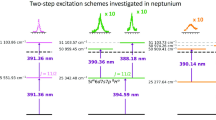Summary
Recently several investigators have obtained exact expressions, which are nonlinear in the photon density, for the cross-section describing laser beam scattering by free electrons. We have studied, in a specific model, the equally interesting problem of laser scattering by bound charged particles. The model consists of a nonrelativistic idealized «molecule», which is composed of two oppositely charged parts bound together in a harmonic oscillator potential. The center of mass of the molecule moves freely. The Hamiltonian which describes the coupled system of molecule and laser field is separated into two parts, each of which depends explicitly on the coupling. We show that the «larger» of these may be exactly diagonalized by a succession of unitary transformations. The exact eigenstates are then used to compute scattering matrix elements. The cross-section for scattering a single photon out of the laser beam is calculated. It is found to depend in a nontrivial way on the structure of the molecule, but it exhibits no nonlinearities such as are found in the free-electron problem. The result is discussed in relation to the free-electron results, and contact is made with the corresponding classical calculation.
Riassunto
Recentemente molti ricercatori hanno ottenuto espressioni esatte, non lineari nella densità fotonica, per la sezione d’urto che descrive lo scattering del fascio del laser su elettroni liberi. Si è studiato, con un modello specifico, il problema egualmente interessante dello scattering del laser su particelle cariche legate. Il modello consiste di una «molecola» ideale non relativistica, composta di due parti con carica opposta legate assieme in un potenziale di oscillatore armonico. Il centro di massa della molecola si muove liberamente. Si divide l’hamiltoniano che descrive il sistema accoppiato della molecola e del campo del laser in due parti, ciascuna delle quali dipende esplicitamente dall’accoppiamento. Si dimostra che la «maggiore» di esse può essere diagonalizzata esattamente con una successione di trasformazioni unitarie. Si usano poi gli autostati esatti per calcolare gli elementi della matrice di scattering. Si calcola la sezione d’urto dello scattering di un solo fotone dal fascio del laser e si trova che dipende in modo non banale dalla struttura della molecola, ma non presenta le non linearità che si trovano nel problema dell’elettrone libero. Si discute il risultato rispetto ai risultati relativi all’elettrone libero e si fa il raffronto con il corrispondente calcolo classico.
Similar content being viewed by others
References
Z. Pried;Phys. Lett.,3, 349 (1963).
L. S. Brown andT. W. B. Kibble:Phys. Rev.,133, A 705 (1964).
I. I. Goldman;Phys. Lett.,8, 103 (1964).
Z. Fried andJ. H. Eberly;Phys. Rev.136, B 871 (1964).
In this regard, note Fried’s conjecture, ref. (1), final paragraph.
O. Von Roos;Phys. Rev.,135, A 43 (1964).
The usefulness of this particular transformation was suggested in a recent unpublished calculation ofL. Hill.
Author information
Authors and Affiliations
Additional information
A preliminary version of this paper was presented at the Conference on Quantum Electrodynamics of High-Intensity Photon Beams, Durham, N.C., August, 1964.
National Academy of Sciences — National Research Council Post-Doctoral Research Associate 1962–1964.
Rights and permissions
About this article
Cite this article
Eberly, J.H., Frank, W.M. Laser scattering from a bound system. Nuovo Cimento B (1965-1970) 41, 113–122 (1966). https://doi.org/10.1007/BF02710378
Received:
Published:
Issue Date:
DOI: https://doi.org/10.1007/BF02710378




